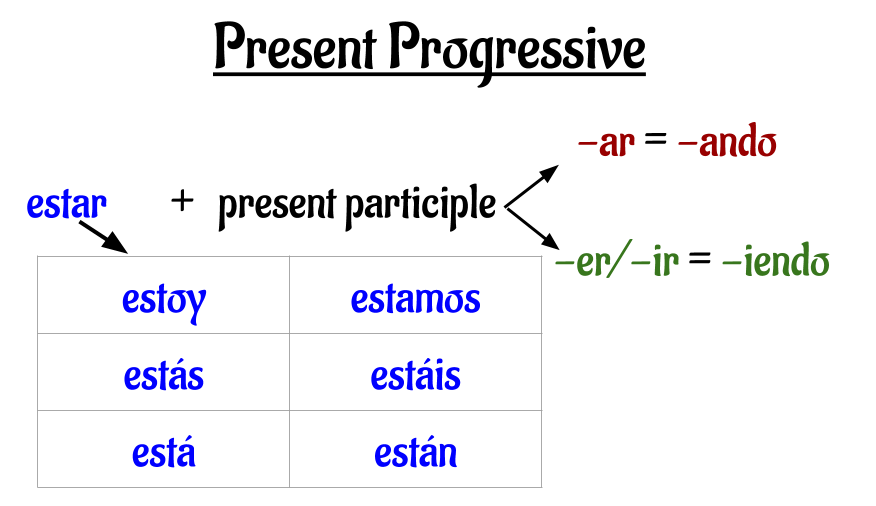El Presente Progresivo
The function in language:
The Present Progressive is used to communicate about events that are currently in progress.
In language the present progressive is used to communicate what is being done now, in the moment. It is formed by using the verb "to be" and another verb with "-ing" on the end.
In Spanish, it is formed by using the correct form of the verb estar (to be) and the verb that follows will have -ando or -iendo replacing the -ar or -er/ir verb ending. This helps communicate what is happening in the moment.
In Spanish, it is formed by using the correct form of the verb estar (to be) and the verb that follows will have -ando or -iendo replacing the -ar or -er/ir verb ending. This helps communicate what is happening in the moment.
How to form the Present Progressive:
|
hablar --> hablando
(hablar - ar + ando) |
comer --> comiendo
(comer - er + iendo) |
vivir --> viviendo
(vivir - ir + iendo) |
Here are some examples and their translations.
|
Juan está jugando un juego de mesa.
Juan is playing a board game. Mi amigo está escribiendo una carta a su novia. My friend is writing a letter to his girlfriend. Yo estoy viviendo con mi tía. I am living with my aunt. |
NOTE: Understand that there are some verbs that have a spell change when turned into the progressive form. These are due to the fact that they are Stem-Changers and an -ir verb.
Stem Changers
|
E → I
pedir = pidiendo preferir = prefiriendo seguir = siguiendo servir = sirviendo decir = diciendo |
O → U
dormir = durmiendo morir = muriendo |
Spell Changers
A change in spelling will happen when the i in the -iendo is preceded by another vowel. What then happens is the i will change to a y for those verbs that have -er and -ir verb endings. Here is a list of a few of the verbs that have this spell change.
A change in spelling will happen when the i in the -iendo is preceded by another vowel. What then happens is the i will change to a y for those verbs that have -er and -ir verb endings. Here is a list of a few of the verbs that have this spell change.
|
leer = leyendo
creer = creyendo construir = construyendo caer = cayendo oír =oyendo incluir = incluyendo concluir = concluyendo |
There are many more verbs that fall into this category, it is just a matter of being familiar with the pattern, then applying it.

